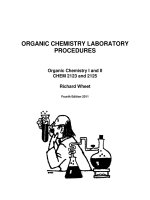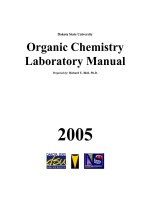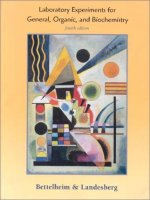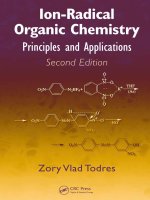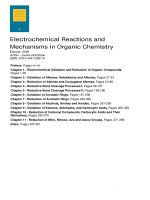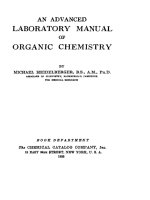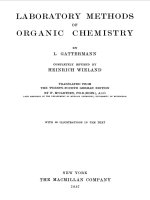Microscale and miniscale organic chemistry laboratory experiments
Bạn đang xem bản rút gọn của tài liệu. Xem và tải ngay bản đầy đủ của tài liệu tại đây (11.74 MB, 688 trang )
Microscale
and Miniscale
Organic Chemistry
Laboratory Experiments
Second Edition
Allen M. Schoffstall
The University of Colorado
at Colorado Springs
and
Barbara A. Gaddis
The University of Colorado
at Colorado Springs
with
Melvin L. Druelinger
Colorado State University-Pueblo
www.pdfgrip.com
MICROSCALE AND MINISCALE ORGANIC CHEMISTRY LAB EXPERIMENTS
SECOND EDITION
Published by McGraw-Hill, a business unit of The McGraw-Hill Companies, Inc., 1221 Avenue of the Americas, New York,
NY 10020. Copyright © 2004, 2000 by The McGraw-Hill Companies, Inc. All rights reserved. No part of this publication
may be reproduced or distributed in any form or by any means, or stored in a database or retrieval system, without the prior
written consent of The McGraw-Hill Companies, Inc., including, but not limited to, in any network or other electronic storage or transmission, or broadcast for distance learning.
Some ancillaries, including electronic and print components, may not be available to customers outside the United States.
This book is printed on acid-free paper.
1 2 3 4 5 6 7 8 9 0 VNH/VNH 0 9 8 7 6 5 4 3
ISBN 0–07–242456–7
Publisher: Kent A. Peterson
Sponsoring editor: Thomas D. Timp
Senior developmental editor: Shirley R. Oberbroeckling
Senior marketing manager: Tamara L. Good-Hodge
Project manager: Joyce Watters
Lead production supervisor: Sandy Ludovissy
Senior media project manager: Stacy A. Patch
Senior media technology producer: Jeffry Schmitt
Senior coordinator of freelance design: Michelle D. Whitaker
Cover/interior designer: Rokusek Design
Cover image: Rokusek Design
Senior photo research coordinator: Lori Hancock
Compositor: Precision Graphics
Typeface: 10/12 Times Roman
Printer: Von Hoffmann Corporation
"Permission for the publication herein of Sadtler Standard Spectrar has been granted, and all rights are reserved, by BIORAD Laboratories, Sadtler Division."
"Permission for the publication of Aldrich/ACD Library of FT NMR Spectra has been granted and all rights are reserved by
Aldrich Chemical."
All experiments contained in this laboratory manual have been performed safely by students in college laboratories under the
supervision of the authors. However, unanticipated and potentially dangerous reactions are possible due to failure to follow
proper procedures, incorrect measurement of chemicals, inappropriate use of laboratory equipment, and other reasons. The
authors and the publisher hereby disclaim any liability for personal injury or property damage claimed to have resulted from
the use of this laboratory manual.
Library of Congress Cataloging-in-Publication Data
Schoffstall, Allen M.
Microscale and miniscale organic chemistry laboratory experiments / Allen M.
Schoffstall, Barbara A. Gaddis, Melvin L. Druelinger.—2nd ed.
p. cm.
Includes bibliographical references and index.
ISBN 0–07–242456–7 (acid-free paper)
1. Chemistry, Organic—Laboratory manuals. I. Gaddis, Barbara A. II. Druelinger,
Melvin L. III. Title.
QD261 .S34 2004
547.0078—dc21
www.mhhe.com
2003008663
CIP
www.pdfgrip.com
Dedication
To Carole, Larry, and Judy for their patience, help, and encouragement.
To organic students who develop a passion for doing and learning from organic laboratory experiments
and to the instructors who make laboratory learning meaningful.
www.pdfgrip.com
Brief Contents
Preface xxi
Introduction 1
Chapter One
Techniques in the Organic Chemistry Laboratory 9
Chapter Two
Spectroscopic Methods and Molecular
Modeling 109
Chapter Three
Chapter Four
Alcohols and Alkyl Halides
Chapter Five
Synthesis of Alkenes
Chapter Six
Chapter Seven
Chapter Eight
Chapter Nine
Chapter Ten
221
229
Alkene Addition Reactions
237
Stereochemistry 255
Introduction to Nucleophilic Substitution
Reactions 261
Dienes and Conjugation
271
Qualitative Organic Analysis I
281
Chapter Eleven
Reactions of Aromatic Side Chains
Chapter Twelve
Electrophilic Aromatic Substitution 298
Chapter Thirteen
Combined Spectroscopy and Advanced
Spectroscopy 323
Chapter Fourteen
Organometallics 351
Chapter Fifteen
Chapter Sixteen
Chapter Seventeen
Chapter Eighteen
iv
Applications Using Laboratory Resources and
Techniques 183
Alcohols and Diols
364
Ethers 376
Aldehydes and Ketones
385
Enols, Enolates, and Enones
404
290
www.pdfgrip.com
Brief Contents
Chapter Nineteen
Chapter Twenty
Carboxylic Acids
419
Carboxylic Acid Esters
430
Chapter Twenty-One
Dicarbonyl Compounds 441
Chapter Twenty-Two
Amines
Chapter Twenty-Three
450
Aryl Halides
475
Chapter Twenty-Four
Phenols
Chapter Twenty-Five
Carbohydrates 489
Chapter Twenty-Six
Chapter Twenty-Seven
Chapter Twenty-Eight
Chapter Twenty-Nine
Lipids
480
507
Amino Acids and Derivatives
518
Qualitative Organic Analysis II
Projects
529
578
Appendix A
Tables of Derivatives for Qualitative Organic
Analysis 627
Appendix B
Laboratory Skills and Calculations
Appendix C
Designing a Flow Scheme
Appendix D
Material Safety Data Sheet 639
Appendix E
Tables of Common Organic Solvents and Inorganic
Solutions 643
Index 645
632
637
v
www.pdfgrip.com
www.pdfgrip.com
Contents
Preface xxi
Introduction 1
1
Important Features of the Organic Lab
1
Goals for the Organic Laboratory
2
Working in the Laboratory
Laboratory Safety
3
Material Safety Data Sheet (MSDS) 5
6
Your Laboratory Notebook
Laboratory Reports
6
How to Be a Successful Organic Laboratory Student 7
Chapter One
Technique A
Techniques in the Organic Chemistry Laboratory 9
9
Glassware and Equipment: Heating and Cooling
Microscale Glassware and Related Equipment 9
Miniscale Glassware 11
13
Additional Glassware and Equipment
13
How to Clean Glassware
How to Heat and Cool Glass Reaction Vessels 14
Technique B
17
Weighing and Measuring
17
How to Weigh Solids and Liquids
Introduction to Measuring Volumes of Liquids
17
How to Use a Calibrated Glass Pipet 18
How to Use an Automatic Delivery Pipet
19
How to Use a Syringe 19
Exercise B.1: Determining Density of an Aqueous Solution
Exercise B.2: Determining Density of an Organic Liquid
Exercise B.3: Calibrating a Pasteur Pipet
Technique C
Melting Points
20
21
21
22
Mixed Melting Behavior
23
Melting Behavior of Solids
23
24
Calibration of the Thermometer
Apparatus for Measuring Melting Points
How to Determine a Melting Point
24
24
Exercise C.1: Calibration of a Thermometer
26
Exercise C.2: Melting Point of an Unknown Solid
Exercise C.3: Mixed Melting Point
26
27
vii
www.pdfgrip.com
viii
Contents
Technique D
Boiling Points
28
28
Intermolecular Attractions
How to Do a Microscale Boiling Point
Determination 29
29
How to Do a Miniscale Boiling Point Determination
Exercise D.1: Determining the Micro Boiling Point of an
Unknown Liquid 30
Exercise D.2: Determining the Boiling Point of an Unknown
Liquid 30
Technique E
Index of Refraction
32
How to Use the Abbe Refractometer 33
Exercise E.1: Measuring the Refractive Index of an Unknown
Liquid
Technique F
33
34
Recrystallization, Filtration, and Sublimation
Solvents for Recrystallization
35
Choosing a Solvent 38
Choosing a Solvent Pair 38
39
How to Do a Microscale Recrystallization
How to Do a Miniscale Recrystallization 41
42
Important Tips Concerning Recrystallization
Introduction to Filtration
43
How to Use a Microscale Filter Pipet 44
How to Do a Miniscale Suction Filtration
44
How to Do a Miniscale Gravity Filtration
44
Important Tips Concerning Filtration
Introduction to Sublimation
45
45
Exercise F.1: Recrystallizing an Impure Solid (microscale)
48
48
Exercise F.3: Recrystallizing an Impure Solid with Hot Gravity
Filtration 49
Exercise F.4: Purifying an Unknown Solid by Solvent-Pair
Recrystallization 50
Exercise F.5: Sublimation of Caffeine 50
Exercise F.6: Sublimation of Caffeine 51
Exercise F.2: Recrystallizing an Impure Solid (miniscale)
Technique G
Distillation and Reflux
52
Microscale Apparatus for Simple Distillation and
Assembly 56
How to Do a Simple Microscale Distillation
56
Important Tips Concerning Microscale Distillation 58
Miniscale Apparatus for Simple Distillation 59
How to Do a Simple Miniscale Distillation 59
Important Tips Concerning Miniscale Distillation
Introduction to Reflux
61
How to Do a Microscale Reaction with Reflux
61
60
www.pdfgrip.com
Contents
62
How to Do a Miniscale Reaction with Reflux
Important Tips on Reflux
62
Evaporation of Solvents
62
Exercise G.1: Distilling a Mixture of Cyclohexane and Toluene
(microscale)
63
Exercise G.2: Distilling a Mixture of Cyclohexane and
Toluene (miniscale)
Technique H
64
Fractional Distillation and Steam Distillation 65
How to Do a Miniscale Fractional Distillation
67
Practical Tips about Miniscale Fractional Distillation
Introduction to Steam Distillation
68
69
Exercise H.1: Miniscale Fractional Distillation of a Mixture
of Cyclohexane and Toluene
70
Exercise H.2: Microscale Fractional Distillation
of Cyclohexane and Toluene
70
Exercise H.3: Steam Distillation of Lemon Grass Oil
(miniscale)
Technique I
71
Extraction and Drying 72
How to Do a Microscale Extraction
74
How to Do a Miniscale Extraction 76
Important Tips Concerning Extraction 76
Drying and Drying Agents
78
How to Do Microscale Drying
How to Do Miniscale Drying
78
79
Important Tips Concerning Drying Agents
79
Exercise I.1: Determining the Distribution Coefficient
of Caffeine (microscale)
80
Exercise I.2: Determining the Distribution Coefficient
of Caffeine (miniscale)
80
Exercise I.3: Using Distribution Coefficients to Identify
Technique J
an Unknown Solid (microscale)
81
Gas-Liquid Chromatography
83
Gas-Liquid Chromatography Basics
Quantitative Analysis
83
87
How to Use the Gas Chromatograph 89
Exercise J.1: Determining Relative Detector Response Factors
in GC
89
Exercise J.2: Determining Mass Percent of a Mixture
Using GC
90
Exercise J.3: Determining Mass Percent of a Mixture
of Alcohols 90
Technique K
Thin-Layer, Column, and High-Performance Liquid
Chromatography 92
Introduction to Thin-Layer Chromatography (TLC)
Introduction to Column Chromatography
How to Do a Miniscale Gravity Column
Chromatography 98
97
92
ix
www.pdfgrip.com
x
Contents
How to Do Microscale Column Chromatography
99
Introduction to High-Performance Liquid
Chromatography (HPLC) 99
Exercise K.1: Analysis of Analgesic Tablets by TLC
101
Exercise K.2: Separating Ferrocene and Acetylferrocene Using
Column Chromatography (microscale) 101
Exercise K.3: Separating Ferrocene and Acetylferrocene Using
Column Chromatography (miniscale) 102
Exercise K.4: HPLC Analysis of Benzaldehyde and Benzyl
Alcohol 102
Technique L
Polarimetry 103
Optical Purity and Enantiomeric Excess 104
How to Measure Optical Rotation
106
Exercise L.1: Determining the Optical Purity of an Unknown
Liquid 107
Exercise L.2: Determining the Melting Points of Enantiomers
and Racemates 107
Chapter Two
Technique M
Spectroscopic Methods and Molecular Modeling 109
Infrared Spectroscopy
110
General Approach to Solving an IR Spectrum 116
Recording an IR Spectrum 116
How to Prepare a Sample for IR Analysis 118
Important Tips Concerning IR 120
Exercise M.1: Recording the IR Spectrum of an Organic
Liquid
122
Exercise M.2: Recording the IR Spectrum of an Organic
Solid
122
Exercise M.3: Spectroscopic Identification of Unknowns
Technique N
122
Nuclear Magnetic Resonance Spectroscopy 125
Chemical Shifts in 1H NMR Spectroscopy 127
Equivalence of Protons in 1H NMR Spectroscopy 129
Integration in 1H NMR Spectroscopy 130
Splitting (coupling) in 1H NMR Spectroscopy 131
Coupling Constants
134
Protons in a Chiral Environment 135
Diastereotopic Protons in Alkenes 136
Protons on Heteroatoms
137
1
Solvents for H NMR Spectroscopy 139
How to Prepare a Sample for 60–90 MHz CW 1H NMR
Spectroscopy 140
How to Prepare a Sample for FT NMR 140
Structural Identification from the NMR Spectrum
140
13
Introduction to C NMR Spectroscopy 143
Solvents for 13C NMR Spectroscopy 146
How to Prepare a Sample for 13C NMR Spectroscopy 146
www.pdfgrip.com
Contents
General Approach to Determining an Unknown
Structure 146
Exercise N.1: Recording a 1H NMR Spectrum
148
Exercise N.2: Recording a C NMR Spectrum 148
Exercise N.3: 1H NMR Spectral Problems 148
Exercise N.4: 13C NMR Spectral Problems 150
Exercise N.5: Spectral Identification Using 1H
and 13C NMR 151
13
Technique O
Ultraviolet and Visible Spectroscopy
154
Uses of UV-Visible Spectroscopy 156
How to Operate a Spectronic 20 158
How to Operate a UV-Visible Spectrometer 159
Technique P
Mass Spectrometry 160
Principles of Mass Spectrometry 160
Fragmentation Patterns
163
Molecular Ion Peak 166
Isotopes
167
167
Gas Chromatography/Mass Spectrometry (GC/MS)
Strategy for Solving Structural Problems Using MS, IR,
and NMR 168
Mass Spectrometric Analysis Guidelines 168
Exercise P.1: Solving Problems in Mass Spectrometry
Technique Q
Molecular Modeling
172
173
Organic Molecular Models
174
Drawing Organic Molecules Using Computer
Software 174
Molecular Modeling Using Computer Software 174
Molecular Mechanics
175
Quantum Mechanics
178
Exercises
180
Exercise Q.1: Conformational Analysis of Butane and Other
Molecules 180
Exercise Q.2: Conformational Analysis of Propane 180
Exercise Q.3: Conformational Analysis of 2-Methylbutane 181
Exercise Q.4: Identifying Reactive Sites 181
Exercise Q.5: Heats of Formation and Dipole Moments 181
Exercise Q.6: LUMO Energies of Alkenes 181
Exercise Q.7: Conformational Analysis of 3-Fluoropropene 182
Chapter Three
Experiment 3.1
Applications Using Laboratory Resources and
Techniques 183
Scavenger Hunt: Introduction to Chemical Data Reference
Books and Calculations
184
Part A: Scavenger Hunt in the Chemical Reference Books
Part B: Scavenger Hunt and Stoichiometric Calculations
187
188
xi
www.pdfgrip.com
xii
Contents
Experiment 3.2
Identification of Organic Liquids by Physical
Properties 189
General Directions 190
Part A: Boiling Point Determination
190
190
Part B: Refractive Index Determination
Experiment 3.3
Relationships Between Structure and Physical
Properties 192
Part A: Determination of the Effect of Structure on Boiling
Point 194
Part B: Determination of the Effect of Structure on Refractive
Index 194
Part C: Determination of the Effect of Structure on Melting
Point 194
Experiment 3.4
Properties of Solvents and Recrystallization of Organic
Solids 197
Part A: Selecting an Appropriate Solvent
198
Part B: Microscale Recrystallization of an Organic Solid
Experiment 3.5
199
Separations Based upon Acidity and Basicity 200
Part A: Determination of Solubilities
202
Part B: Microscale Separation of Naphthalene, Benzoic Acid,
and Ethyl 4-Aminobenzoate 203
Part C: Miniscale Separation of Benzoic Acid and Ethyl
4-Aminobenzoate 204
Experiment 3.6
Isolation of a Natural Product 205
Part A: Miniscale Extraction of Caffeine from Tea Leaves
207
Part B: Miniscale Extraction of Caffeine from Instant
Coffee 208
Part C: Miniscale Isolation of Caffeine from NoDoz 209
Part D: Miniscale Isolation of Cholesterol from Simulated
Gallstones 209
Experiment 3.7
Solvent and Polarity Effects in Thin-layer
Chromatography (TLC) 210
Part A: Determining the Effect of Polarity on Elution
212
Part B: Separation and Identification of Components of a Mixture
of trans-Stilbene, 9-Fluorenone, and Benzoic Acid 214
Experiment 3.8
Purification and Analysis of a Liquid Mixture: Simple
and Fractional Distillation
216
Part A: Microscale Distillation
217
Part B: Microscale Fractional Distillation
218
Part C: Miniscale Distillation 218
Part D: Miniscale Fractional Distillation 219
Chapter Four
Alcohols and Alkyl Halides
221
Experiment 4.1
Synthesis of an Alkyl Halide from an Alcohol 221
Experiment 4.2
Selectivity of Free Radical Chlorination
of 2,3-Dimethylbutane 224
www.pdfgrip.com
Contents
Chapter Five
Experiment 5.1
Synthesis of Alkenes
229
Alkenes Via Acid-catalyzed Dehydration
of Alcohols 229
Part A: Microscale Synthesis of Alkenes Via Acid-catalyzed
Dehydration of 3-Methyl-3-pentanol
231
Part B: Miniscale Synthesis of Alkenes Via Acid-catalyzed
Dehydration of 3,3-Dimethyl-2-butanol 231
Part C: Microscale Synthesis of Alkenes Via Acid-catalyzed
Dehydration of an Unknown Alcohol 232
Experiment 5.2
Alkenes Via Base-Induced Elimination of Alkyl
Halides 234
Chapter Six
Alkene Addition Reactions 237
Experiment 6.1
Catalytic Hydrogenation of Alkenes
237
Part A: Microscale Hydrogenation of 1-Decene
239
240
Part C: Microscale Partial Hydrogenation of Olive Oil 241
Part B: Microscale Hydrogenation of Allylbenzene
Experiment 6.2
Hydration of Alkenes 242
Part A: Microscale Hydration of 2-Ethyl-1-butene
Part B: Microscale Hydration of Norbornene
Part C: Miniscale Hydration of Norbornene
Experiment 6.3
244
245
245
Preparation of Alcohols from Alkenes
by Hydroboration-oxidation 246
Part A: Microscale Hydroboration-oxidation
of 3,3-Dimethyl-1-butene 249
Part B: Miniscale Hydroboration-oxidation
of 3,3-Dimethyl-1-butene 249
Experiment 6.4
Addition Polymers: Preparation of Polystyrene and Polymethyl
Methacrylate
251
Part A: Miniscale Polymerization of Styrene (Bulk Method)
253
Part B: Microscale Polymerization of Styrene (Solution
Method) 253
Part C: Miniscale Polymerization of Methyl Methacrylate (Bulk
Method) 253
Chapter Seven
Experiment 7.1
Stereochemistry 255
Stereochemistry of Alkenes and Derivatives 255
Part A: Microscale Cis-Trans Isomerization of an Alkene
Part B: Microscale Addition of Bromine to Fumaric Acid
258
258
Part C: Determining the Mechanism of the Isomerization
of Dimethyl Maleate to Dimethyl Fumarate (Miniscale) 259
Chapter Eight
Introduction to Nucleophilic Substitution
Reactions 261
Experiment 8.1
Relative Rates of Nucleophilic Substitution
Reactions 261
Part A: Determination of Factors Affecting the Relative Rates
of SN2 Reactions 263
Part B: Determination of Factors Affecting the Relative Rates
of SN1 Reactions 264
xiii
www.pdfgrip.com
xiv
Contents
Experiment 8.2
Nucleophilic Aliphatic Substitution: Synthesis
of 1-Bromobutane
267
Part A: Microscale Synthesis of 1-Bromobutane
Part B: Miniscale Synthesis of 1-Bromobutane
Chapter Nine
Experiment 9.1
Dienes and Conjugation
268
269
271
Dienes and the Diels-Alder Reaction 271
Part A: Microscale Reaction of 1,3-Butadiene
with Maleic Anhydride 276
Part B: Miniscale Reaction of 2,3-Dimethyl-1,3-butadiene
with Maleic Anhydride 277
Part C: Microscale Reaction of Cyclopentadiene with Maleic
Anhydride 277
Part D: Miniscale Reaction of Cyclopentadiene with Maleic
Anhydride 277
Part E: Miniscale Reaction of Anthracene with Maleic
Anhydride 278
Chapter Ten
Qualitative Organic Analysis I
Experiment 10.1
Qualitative Analysis of Alkyl Halides, Alkenes, Dienes,
and Alkynes 281
Chapter Eleven
Experiment 11.1
281
Reactions of Aromatic Side Chains
290
Benzylic Oxidation: Benzoic Acid from Toluene; A Phthalic Acid
from an Unknown Xylene
290
Part A: Microscale Oxidation of Toluene to Benzoic Acid
Part B: Microscale Oxidation of a Xylene to a Phthalic Acid
Chapter Twelve
292
293
Electrophilic Aromatic Substitution 298
Experiment 12.1
Activating and Deactivating Effects of Aromatic
Substituents: Relative Rates of Bromination 299
Experiment 12.2
Nitration of Methyl Benzoate or an Unknown
304
Part A: Microscale Nitration of Methyl Benzoate
306
306
Part C: Miniscale Nitration of an Unknown Aromatic
Compound 307
Part B: Miniscale Nitration of Methyl Benzoate
Experiment 12.3
Friedel-Crafts Acylation Reactions
310
Part A: Microscale Procedure for Acetylation of Biphenyl
312
Part B: Microscale Procedure for Acetylation of Phenanthrene
with TLC Analysis 313
Part C: Microscale Benzoylation of Ferrocene with Column
Chromatography 314
Experiment 12.4
Aromatic Bromination
316
Part A: Microscale Bromination of Acetanilide
317
Part B: Microscale Bromination of p-Methylacetanilide with
TLC and Column Chromatography or HPLC Analysis 319
Part C: Experimental Design of a Procedure for Bromination
of an Acetanilide Derivative 320
www.pdfgrip.com
Contents
Chapter Thirteen
Experiment 13.1
Combined Spectroscopy and Advanced
Spectroscopy 323
Infrared and Nuclear Magnetic Resonance
Spectroscopy of Alcohols, Ethers, and Phenols
323
Part A: Experimental Procedure for Infrared Spectroscopy
326
Part B: Experimental Procedure for IR and NMR
Spectroscopy 326
Part C: Exercises for IR and NMR Spectroscopy 327
Experiment 13.2
Combined Spectral Analysis: Infrared, Ultraviolet, and Nuclear
332
Magnetic Resonance Spectroscopy and Mass Spectrometry
Solved Examples of the Use of Combined
Spectroscopy 333
Part A: Purification of the Unknown
341
Part B: Preparation of the Sample and Spectroscopic
Analysis 341
Part C: Spectroscopic Exercises 342
Chapter Fourteen
Experiment 14.1
Organometallics 351
Grignard Synthesis: Preparation of Triphenylmethanol and
3-Methyl-2-phenyl- 2-butanol
351
Part A: Microscale Synthesis of Triphenylmethanol
from Benzophenone
354
Part B: Miniscale Synthesis of Triphenylmethanol from Ethyl
Benzoate 355
Part C: Microscale Synthesis of
3-Methyl-2-phenyl-2-butanol 358
Experiment 14.2
Using Indium Intermediates: Reaction of Allyl Bromide
with an Aldehyde
Chapter Fifteen
Experiment 15.1
360
Alcohols and Diols
364
Stereoselective Reduction of Ketones with Sodium
Borohydride 364
Part A: Microscale Reduction of Benzil
366
Part B: Microscale Reduction of (1R)-(+)-Camphor 366
369
Experiment 15.2
Experimental Design for an Alcohol Oxidation
Experiment 15.3
Photochemical Oxidation of Benzyl Alcohol 373
Chapter Sixteen
Experiment 16.1
Ethers 376
Ether Synthesis by SN2 Displacement 376
Part A: Microscale Preparation of an Alkyl Halophenyl
Ether 378
Part B: Miniscale Preparation of Benzyl tert-Butyl Ether 379
Experiment 16.2
Nucleophilic Aliphatic Substitution Puzzle: Substitution
Versus Elimination
Chapter Seventeen
Experiment 17.1
380
Aldehydes and Ketones
385
Stereoselective Synthesis of Alkenes 386
Part A: Microscale Wittig Synthesis of
trans-9-(2-phenylethenyl)anthracene 388
xv
www.pdfgrip.com
xvi
Contents
Part B: Miniscale Wittig Synthesis of
trans-9-(2-phenylethenyl)anthracene 389
Part C: Microscale Horner-Emmons Reaction of Diethylbenzyl
Phosphonate and Benzaldehyde 390
Experiment 17.2
393
Conversion of Cyclohexanone to Caprolactam
Part A: Microscale Conversion of Cyclohexanone
to Caprolactam
395
Part B: Miniscale Conversion of Cyclohexanone
to Caprolactam
Experiment 17.3
395
Pinacol Rearrangement and Photochemical Synthesis
of Benzopinacol 399
Part A: Microscale Synthesis of Pinacolone
400
Part B: Miniscale Photoreduction of Benzophenone
401
402
Part C: Miniscale Synthesis of Benzopinacolone
Chapter Eighteen
Experiment 18.1
Enols, Enolates, and Enones
404
Preparation of `,a-Unsaturated Ketones Via Mixed Aldol
Condensation 404
Part A: Miniscale Synthesis of 1,9-Diphenyl-1,3,6,8-
nonatetraen-5-one (Dicinnamalacetone) 407
Part B: Microscale Synthesis of Dibenzalacetone
(1,5-Diphenyl-1,4-pentadien-3-one) 408
Part C: Identification of a Mixed Aldol Product from the
Miniscale Condensation of an Unknown Aromatic Aldehyde
with a Ketone 410
Experiment 18.2
Reduction of Conjugated Ketones with Sodium
Borohydride 411
Part A: Microscale Reduction of 2-Cyclohexenone
412
Part B: Microscale Reduction of
trans-4-Phenyl-3-buten-2-one 413
Experiment 18.3
Identification of Products of Catalytic Transfer
414
Hydrogenation of an Enone
Part A: Microscale Reaction of 2-Cyclohexenone
Part B: Miniscale Reaction of 2-Cyclohexenone
Chapter Nineteen
Carboxylic Acids
416
416
419
Experiment 19.1
Synthesis and Identificatoin of an Unknown Carboxylic
Acid 419
Experiment 19.2
Synthesis of trans-Cinnamic Acid Via the Haloform
Reaction 425
Chapter Twenty
Experiment 20.1
Carboxylic Acid Esters
430
Combinatorial Chemistry and the Synthesis of Fruity
Esters 430
Part A: Combinatorial Selection
432
Part B: Microscale Synthesis of an Ester
Experiment 20.2
433
Synthesis of Esters by Baeyer-Villiger Oxidation
436
Part A: Microscale Oxidation of an Unknown Cyclic Ketone
Part B: Miniscale Oxidation of Cyclohexanone
438
437
www.pdfgrip.com
Contents
Chapter Twenty-One
Experiment 21.1
Dicarbonyl Compounds 441
Base-Catalyzed Condensations of Dicarbonyl
Compounds 441
Part A: Microscale Preparation of Coumarin or a Coumarin
Derivative 444
Part B: Miniscale Preparation of Coumarin or a Coumarin
Derivative 444
Experiment 21.2
Reactions of Diketones: Synthesis of 2,5-Dimethyl1-phenylpyrrole and Preparation of an Unknown Pyrrole
445
Part A: Microscale Synthesis of
2,5-Dimethyl-1-phenylpyrrole 447
Part B: Microscale Preparation of an Unknown Pyrrole
Chapter Twenty-Two
Experiment 22.1
Amines
448
450
Relating Color to Structure: Synthesis of Azo Dyes
450
Part A: Miniscale Diazotization of an Aromatic Amine
454
455
Part B.2: Miniscale Coupling with an Amine 455
Part C: Direct Dyeing with an Azo Dye 455
Part D: Recording the UV-Visible Spectrum of the Prepared
Dyes 455
Part E: Determining the pH Indicator Range of the Prepared
Dyes 455
Part F: Determining Antibacterial Properties of the Dye 456
Part B.1: Miniscale Coupling with a Phenol
Experiment 22.2
Synthesis of Pyrazole and Pyrimidine Derivatives 457
Part A: Microscale Synthesis of a Five-Member Ring
Heterocycle from Hydrazine and an Unknown Diketone
461
Part B: Miniscale Synthesis of a Five-Member Ring
Heterocycle from Hydrazine and an Unknown Diketone 461
Part C: Microscale Synthesis of a Substituted Pyrimidine 462
Part D: Miniscale Synthesis of a Substituted Pyrimidine 462
Experiment 22.3
Synthesis of Heterocyclic Compounds
464
Part A: Miniscale Reaction of Benzaldehyde and Pyrrole
Part B: Microscale Reaction of o-Phenylenediamine and
Formic Acid 467
Experiment 22.4
Synthesis of Heterocycles and Kinetics
by Spectroscopic Analysis 469
Part A: Miniscale Preparation of Lophines
(2-Aryl-4,5-diphenylimidazoles) 471
Part B: Miniscale Synthesis of Substituted Lophinyl
(2-Aryl-4,5-diphenylimidazole) Dimers 471
Part C: Kinetics of the Recombination Reaction
Chapter Twenty-Three
Experiment 23.1
Aryl Halides
475
Nucleophilic Aromatic Substitution
475
Part A: Microscale Reaction of Sodium Ethoxide
with 1-Bromo-2,4-dinitrobenzene
477
Part B: Microscale Reaction of Sodium Ethoxide
with p-Fluoronitrobenzene
477
472
466
xvii
www.pdfgrip.com
xviii
Contents
Chapter Twenty-Four
Experiment 24.1
Phenols
480
Exploring Structure-function Relationships of Phenols:
Synthesis of Salicylic Acid, Aspirin, and Vanillin Derivatives
480
Part A: Miniscale Reactions of Vanillin
483
PartB: Miniscale Hydrolysis of Methyl Salicylate 485
Part C: Miniscale Synthesis of Acetylsalicylic Acid 486
Chapter Twenty-Five
Experiment 25.1
Carbohydrates 489
Classification of Sugars and Identification of an
Unknown Sugar 490
General Instructions for the Microscale Identification
of an Unknown Sugar 495
Part A: Osazone Formation
Part B: Chemical Tests
Experiment 25.2
496
496
Esterification of Sugars: Preparation of Sucrose Octaacetate
and `- and a-D-Glucopyranose Pentaacetate
498
Part A: Miniscale Preparation of D-Sucrose Octaacetate
500
Part B: Microscale Preparation of β-D-Glucopyranose
Pentaacetate 501
Part C: Microscale Conversion of β-D-Glucopyranose
Pentaacetate to the a-Anomer 502
Part D: Miniscale Preparation of α-D-Glucose Pentaacetate
and Measurement of Optical Rotation 503
Chapter Twenty-Six
Experiment 26.1
Lipids
507
Soap from a Spice: Isolation, Identification, and Hydrolysis
of a Triglyceride
507
Part A: Miniscale Isolation of a Triglyceride from Nutmeg
Part B: Microscale Hydrolysis of a Triglyceride
509
510
Part C: Determination of Properties of the Soap
from Nutmeg 511
Experiment 26.2
Chapter Twenty-Seven
Experiment 27.1
Preparation of Esters of Cholesterol and Determination
of Liquid Crystal Behavior 512
Amino Acids and Derivatives 518
Conversion of an Amino Acid to a Sunscreen: Multistep
Preparation of Benzocaine or a Benzocaine Analog
518
Part A: Miniscale Synthesis of p-Methylacetanilide
521
Part B: Miniscale Synthesis of p-Acetamidobenzoic Acid
522
523
Part D: Microscale Esterification of p-Aminobenzoic Acid 525
Part E: Determining the Effectiveness of the p-Aminobenzoic
Acid Ester as a Sunscreen 526
Part C: Miniscale Synthesis of p-Aminobenzoic Acid
Chapter Twenty-Eight
Experiment 28.1
Qualitative Organic Analysis II
529
Designing a Classification Scheme for Characterizing
an Organic Compound 529
Part A: Microscale Solubility Tests
Part B: Microscale Chemical Tests
530
531
www.pdfgrip.com
Contents
Part C: Microscale Classification of an Unknown
Compound 536
Experiment 28.2
Experimental Methods of Qualitative Organic
Analysis 537
Introduction to Qualitative Organic Analysis
537
538
Overall Approach to Identifying the Unknown
Step 1: Purify
538
Step 2: Determine the Physical Properties 538
Step 3: Examine the Physical State 538
Step 4: Perform Solubility Tests
538
540
Step 5: Identify the Functional Groups Present
Step 6: Select an Appropriate Derivative 551
Step 7: Prepare and Purify the Derivative 552
Step 8: Identify the Unknown
557
Experimental Procedure 557
Part A: Purification of the Unknown
559
559
Part C: Chemical Tests (Arranged Alphabetically)
Part D: Derivatives 566
Part B: Solubility Tests
Part E
560
Qualitative Organic Analysis of Unknowns 574
Part E.1: Qualitative Analysis of Aldehydes and Ketones
Part E.2: Qualitative Analysis of Alcohols and Phenols
574
575
Part E.3: Qualitative Analysis of Amines and Carboxylic
Acids 575
Part E.4: Qualitative Analysis of a General Unknown
575
Part E.5: Qualitative Analysis and Spectroscopic Analysis
of a General Unknown 575
Chapter Twenty-Nine
Experiment 29.1
Projects
578
Multistep Synthesis of 1-Bromo-3-chloro-5-iodobenzene
from Aniline 579
Part A: Synthesis of Acetanilide from Aniline
583
Part B: Miniscale Synthesis of 4-Bromoacetanilide
from Acetanilide 585
Part C: Synthesis of 4-Bromo-2-chloroacetanilide
from 4-Bromoacetanilide 586
Part D: Synthesis of 4-Bromo-2-chloroaniline from 4-Bromo2-chloroacetanilide 587
Part E: Miniscale Synthesis of 4-Bromo-2-chloro-6-iodoaniline
from 4-Bromo-2-chloroaniline 589
Part F: Synthesis of 1-Bromo-3-chloro-5-iodobenzene
from 4-Bromo-2-chloro-6-iodoaniline 590
Experiment 29.2
Multistep Synthesis of Sulfanilamide Derivatives as
Growth Inhibitors 592
Part A: Preparation of Acetanilide
594
Part B: Preparation of p-Acetamidobenzenesulfonyl
Chloride 595
xix
www.pdfgrip.com
xx
Contents
Part C: Reaction of p-Acetamidobenzenesulfonyl Chloride
with an Amine 595
Part D: Hydrolysis of the Acetamido Group 596
Part E: Bacterial Testing of Antibiotic Susceptibility 596
Part A: Miniscale Synthesis of Acetanilide
597
Part B: Miniscale Synthesis of p-Acetamidobenzenesulfonyl
Chloride 597
Part C: Miniscale Synthesis of Sulfonamides 598
Part D: Miniscale Synthesis of Sulfanilamides 599
Part E: Bacterial Testing of Antiobiotic Susceptibility
Experiment 29.3
600
Structural Determination of Isomers Using Decoupling
and Special NMR Techniques 602
Part A: Homonuclear Decoupling of a Known Alkene
and Determination of Coupling Constants 612
Part B: Characterization of an Unknown Compound Using
Homonuclear Decoupling in 1H NMR 612
Part C: Characterization of an Unknown Compound Using
1
H NMR, 13C NMR, 1H-1H (COSY) and HETCOR
(1H-13C COSY) 613
Experiment 29.4
The Library-Laboratory Connection
614
Part A: Chemical Abstracts (CA) and Beilstein
Part B: Searching Science Library Databases
Part C: Searching on the Web
Experiment 29.5
614
619
620
Stereochemistry, Molecular Modeling, and
Conformational Analysis 621
Part A: Molecular Models Using a Model Kit
624
625
Part C: Conformational Analysis of Rotational Isomers 625
Part D: Using Molecular Modeling to Analyze Rotational
Conformations of Stereoisomers 625
Part B: Computer Modeling
Appendix A
Tables of Derivatives for Qualitative Organic
Analysis 627
Appendix B
Laboratory Skills and Calculations
Appendix C
Designing a Flow Scheme
Appendix D
Material Safety Data Sheet 639
Appendix E
Tables of Common Organic Solvents and Inorganic
Solutions 643
Index 645
632
637
www.pdfgrip.com
Preface to Second Edition
This book is a comprehensive introductory treatment of the organic chemistry laboratory. The student will be guided in doing numerous exercises to learn basic laboratory
techniques. The student will then use many proven traditional experiments normally
performed in the two-semester organic laboratory course.
Several trends in organic laboratory education have emerged since publication of
the first edition. These trends are recognition of the pedagogical value of discovery
experiments, the increased emphasis on molecular modeling and computer simulations,
and the development of green experiments. All of these trends are incorporated into this
book along with the use of traditional experiments.
DISCOVERY EXPERIMENTS
Discovery experiments are given a special label in the Table of Contents and in each
chapter where they appear. Discovery experiments incorporate the pedagogical advantages of inductive inquiry experiments with the ease of design found in expository
experiments. Discovery experiments (or guided inquiry experiments) have a specific
procedure designed to give a predetermined but unspecified result. Students use a
deductive thought process to arrive at a desired conclusion. Students are “guided” by
inferring a general scientific principle. Discovery experiments have been employed
successfully in large laboratory sections, as well as in small classroom environments.
Student interest is increased during discovery experiments because the result of the
experiment is unknown to the student. The desired goal of discovery experiments is
increased student learning. Discovery experiments can also provide the opportunity
for individual reflection and class discussion and may involve students in developing
and interpreting laboratory procedures. These features and advantages of discovery
experiments have caused your text authors to emphasize discovery experiments in this
edition of the text.
MOLECULAR MODELING
Molecular modeling by computer saw a revolution in the late 1990s with the advent of
affordable, sufficiently fast personal computers with adequate memory. Computer modeling enhances the benefits of assembling molecular models using model kits. Use of
these kits is still encouraged. However, gone are the days where students had to depend
only on molecular model kits to represent molecules in three dimensions. While these
models still have their uses, computer modeling programs now provide exciting visualization of molecules and calculation of physical properties and thermodynamic parameters. Where possible, it is desirable to incorporate computer modeling into organic
laboratory programs. The exercises in this book can be done using relatively inexpensive commercial software from one or more providers.
xxi
www.pdfgrip.com
xxii
Preface
COMPUTER SIMULATION OF EXPERIMENTS
Another use of computers is for simulation of laboratory procedures and experiments.
Demonstrations of laboratory techniques are available as clips on the CD accompanying this text. Simulations of experiments are useful as prelab exercises to familiarize
students with the experiment and to enhance learning in the laboratory. Simulations are
also useful as illustrations of experiments that are difficult to carry out in the undergraduate laboratory environment. Experiments that require special equipment, inert gaseous
environments, or especially noxious and toxic reagents can be experienced by students
through virtual experiments on the computer. Examples of such experiments are available on the CD accompanying this text.
GREEN CHEMISTRY
Academic and industrial organic chemists have led an initiative to replace the use of
organic solvents with aqueous solvents. They have encouraged the recycling of chemicals in order to reduce production requirements of chemicals. They have encouraged
use of environmentally benign reagents in place of hazardous and toxic reagents where
possible. In this text, there have been efforts to reduce quantities of toxic reagents and
solvents wherever possible and to develop “green” experiments. For example, new
Experiment 14.2 is on the use of indium reagents in aqueous solvents to accomplish
coupling reactions similar to Grignard reactions. Another objective of green chemistry
is to prevent waste. In this book, microscale and miniscale experiments are used in
order to help minimize waste.
MICROSCALE AND MINISCALE TECHNIQUES
Microscale and miniscale organic techniques were first introduced two decades ago.
However, changing over to new, smaller glassware and equipment has been slow in
some laboratories for a number of reasons. One reason is the initial cost, but most institutions benefit by reduced costs of chemicals and hazardous waste disposal. The decision
of whether to use a microscale procedure or a miniscale procedure often depends on the
methods of characterization chosen by the instructor. This governs how much product is
required for analysis. If a distillation is desired, a miniscale procedure is often chosen
because of difficulties associated with distilling very small quantities of liquid. If an
analysis of liquid products is to be done only by gas chromatographic analysis, a
microscale procedure will cut down on costs of waste disposal.
NEW FEATURES IN THE SECOND EDITION
Accompanying a new section on molecular modeling, significant additions to this edition include expanded coverage of Diels-Alder chemistry, inclusion of enone chemistry
with a chapter on enols, a new chapter on dicarbonyl compounds, and expanded coverage of heterocycles in the chapter on amines. New experiments and new options within
experiments are included in many chapters. Many are discovery experiments. Among
these are
Experiment 3.3, Relationships Between Structure and Physical Properties;
Experiment 3.8, Purification and Analysis of a Liquid Mixture;
Experiment 5.1B, Miniscale Synthesis of Alkenes Via Acid-catalyzed Dehydration
of 3,3-Dimethyl-2-butanol;
www.pdfgrip.com
Preface
Experiment 9.1C, Microscale Reaction of Cyclopentadiene with Maleic Anhydride;
Experiment 9.1E, Reaction of Anthracene with Maleic Anhydride;
Experiment 14.2, Using Indium Intermediates: Reaction of Allyl Bromide with an
Aldehyde;
Experiment 15.3, Photochemical Oxidation of Benzyl Alcohol;
Experiment 16.2, Nucleophilic Aliphatic Substitution Puzzle: Substitution Versus
Elimination;
Experiment 17.1C, Microscale Horner-Emmons Reaction of Diethylbenzyl
Phosphonate and Benzaldehyde;
Experiment 18.2A, Microscale Reduction of 2-Cyclohexenone;
Experiment 18.2B, Microscale Reduction of trans-4-Phenyl-3-buten-2-one;
Experiment 18.3, Catalytic Transfer Hydrogenation Miniscale Reaction
of Cyclohexenone;
Experiment 21.1, Base-Catalyzed Condensations of Dicarbonyl Compounds;
Experiment 22.2, Synthesis of Pyrazole and Pyrimidine Derivatives;
Experiment 24.1, Exploring Structure-function Relationships of Phenols;
Experiment 26.1, Soap from a Spice: Isolation, Identification and Hydrolysis
of a Triglyceride;
Experiment 26.2, Preparation of Esters of Cholesterol and Determination of Liquid
Crystal Behavior;
Experiment 29.2, Multistep Synthesis of Sulfanilamide Derivatives as Growth
Inhibitors;
Experiment 29.3, Structural Determination of Isomers Using Decoupling and
Special NMR Techniques.
INSTRUCTOR’S MANUAL
An instructor’s manual is available on the website accompanying this text. This manual
includes directions for laboratory preparators, instructor’s notes for each experiment,
solutions to problems, and prelab and postlab assignments. Test questions about many
experiments are available on the web CT.
COURSE WEBSITE
The website offers supportive backup for the organic
laboratory course. It presents updated helpful hints for lab preparators and instructors,
typical schedules, sample electronic report forms, sample quiz and exam questions,
examples of lab lecture or material for self-paced prelab student preparation, and relevant links to other websites. Some additional experiments are available on the website.
ACKNOWLEDGMENTS
We wish to acknowledge several individuals who have contributed to the second edition.
Connie Pitman, laboratory technician at the University of Colorado Springs, has made
numerous valuable comments about the experiments. She has also coauthored the
Instructor’s Manual and Solutions Guide. Shirley Oberbroeckling has served as the
Developmental editor and Joyce Watters as the Project Manager for this edition of the
text. The following faculty and students have contributed to the second edition by testing
experiments and suggesting improvements:
Robert A. Banaszak, Anna J. Espe, Sam T. Seal, Shannon J. Coleman, Shannon R.
Gilkes, Molly M. Simbric, Daniela Dumitru, Patricia D. Gromko, Amy M. Scott,
xxiii
www.pdfgrip.com
xxiv
Preface
Tomasz Dziedzic, Paul J. Lunghofer, Rafael A. Vega, Justin A. Russok, Darush Fathi,
and Michael Slogic.
We are grateful to the following individuals who served as reviewers for this edition. They are:
Monica Ali, Oxford College
Steven W. Anderson, University of Wisconsin - Whitewater
Satinder Bains, Arkansas State University - Beebe
David Baker, Delta College
John Barbaro, University of Alabama - Birmingham
George Bennett, Milikin University
Cliff Berkman, San Francisco State University
Lea Blau, Stern College for Women
Lynn M. Bradley, The College of New Jersey
Bruce S. Burnham, Rider College
Patrick E. Canary, West Virginia Northern Community College
G. Lynn Carlson, University of Wisconsin - Kenosha
Jeff Charonnat, California State University - Northridge
Wheeler Conover, Southeast Community College
Wayne Counts, Georgia Southwestern State University
Tammy A. Davidson, East Tennessee State University
David Forbes, University of South Alabama - Mobile
Eric Fossum, Wright State University - Dayton
Nell Freeman, St. Johns River Community College
Edwin Geels, Dordt College
Jack Goldsmith, University of South Carolina - Aiken
Ernest E. Grisdale, Lord Fairfax Community College
Tracy Halmi, Pennsylvania State Behrend - Erie
C. E. Heltzel, Transylvania University
Gary D. Holmes, Butler County Community College
Harvey Hopps, Amarillo College
William C. Hoyt, St. Joseph’s College
Chui Kwong Hwang, Evergreen Valley College
George F. Jackson, University of Tampa
Tony Kiessling, Wilkes University
Maria Kuhn, Madonna University
Andrew Langrehr, Jefferson College
Elizabeth M. Larson, Grand Canyon University
John Lowbridge, Madisonville Community College
William L. Mancini, Paradise Valley Community College
John Masnovi, Cleveland State University
Anthony Masulaitis, New Jersey City University
Ray Miller, York College
Tracy Moore, Louisiana State University - Eunice
Michael D. Mosher, University of Nebraska - Kearney
Michael J. Panigot, Arkansas State University
Neil H. Potter, Susquehanna University
Walda J. Powell, Meredith College
John C. Powers, Pace University
Steve P. Samuel, SUNY - Old Westbury
Greg Spyridis, Seattle University
www.pdfgrip.com
Preface
Paris Svoronos, Queensboro Community College
Eric L. Trump, Emporia State University
Patibha Varma Nelson, St. Xavier University
Chad Wallace, Asbury College
David Wiendenfeld, University of North Texas
Linfeng Xie, University of Wisconsin - Oshkosh
We hope you find your laboratory experience profitable and stimulating.
xxv

